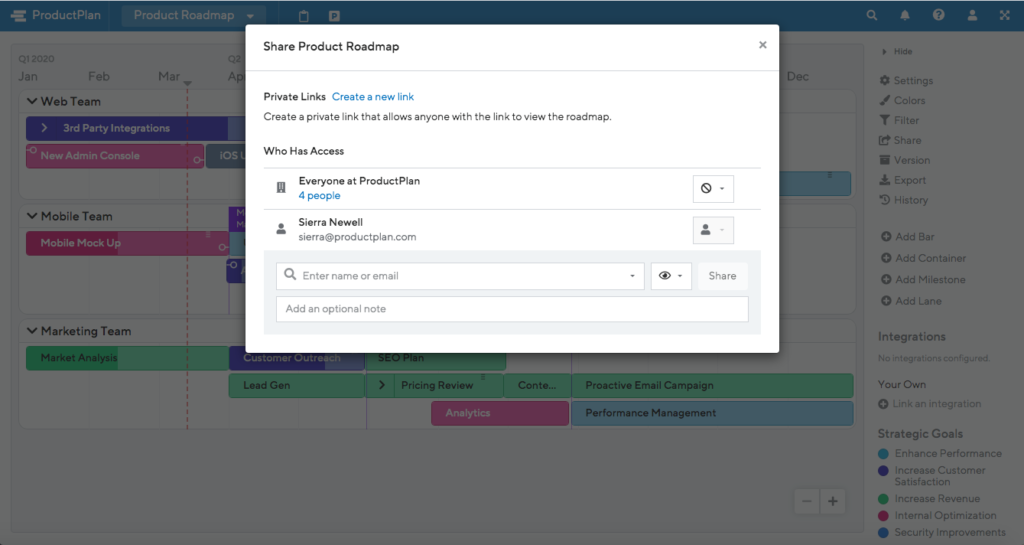Have you reviewed your list of New Year’s Resolutions recently? Statistically speaking, you won’t like what you see. According to research in Inc. Magazine, 80% of us fall short of the goals we set each January 1. It can feel upsetting on a personal level if you promised yourself to declutter or start meditating this year. But if you set a goal to improve your product roadmapping habits, letting that resolution slide can also harm your product, your company, and your career.
So, let’s get you back on track. In this post, we’ll discuss some habits that will help you keep your roadmap more accurate, up to date, and useful all year long. First, though, a few words on why developing these roadmap habits is so essential to the success of your products.
Why Good Roadmapping Habits Matter
Think of your product roadmap like a lighthouse. The light it casts helps your team make sure they’re moving in the right direction, even when the ultimate goal is far off in the distance, and even when they have to deal with more immediate obstacles.
The light also alerts your team to dangers ahead. Reviewing your roadmap can let you know your team is deploying its limited resources inefficiently. It can also alert you that you’re nearing a deadline and haven’t made the progress you had planned.
But to be useful as a navigational guide, a lighthouse (and your roadmap) needs maintenance.
Not a perfect metaphor, but you get the idea. To make sure your product roadmap keeps your team on the right strategic track, you need to serve as the “roadmap keeper.” You need to make sure your roadmap stays accurate, up to date, and that it reflects your product’s single source of truth.
So, let’s discuss some roadmapping best practices. As the old saying goes, that roadmap isn’t going to maintain itself. (Yeah, I know. But it should be.)
5 Roadmapping Habits You Should Develop
1. Make Your Roadmap Accessible to Relevant Stakeholders
A lighthouse works only to the extent that people can see it. The same is true for your roadmap. You don’t want to develop a product roadmap and then keep it in a drawer or in a file only you can access. That eliminates most of the roadmap’s usefulness.
Instead, make your roadmap available and easy to access for everyone on your cross-functional team. That could include your developers, your sales, and marketing teams, your project management team, your designers, your executive staff.
The best way to do this is by using web-based roadmap software. A roadmap app lets you spin up a new roadmap in minutes, share it with all of the right stakeholders, and then keep it live and available online 24/7.
With ProductPlan, for example, you can share your product roadmap easily with just a few clicks, as you can see from the screenshot below.


Note: When you share your roadmap, it becomes even more important that you keep it updated at all times. The last thing you want is for your developers or executives to view an outdated roadmap and make inaccurate strategic decisions based on this bad information.
2. Create a Consistent Process for Adding to the Roadmap
To make sure your roadmap reflects your team’s single source of truth, your team will need to be confident that everything on the roadmap belongs there, and that nothing makes it onto the roadmap without team vetting and evidence to show its strategic value.
Establish a process for adding initiatives to the roadmap—and always stick to that process. For example, you might develop the following four-step method that every idea has to go through before earning a slot on the roadmap:
1. Someone adds a strategic idea to the roadmap’s Parked Section.
2. The team discusses and evaluates the idea: in a sprint planning session, strategic meeting, etc.
3. If it passes this initial evaluation, someone takes responsibility for researching the idea: conducting user surveys, analyzing usage data, or evaluating other available information.
4. If the data suggest the idea will add value to the product, the team meets to decide how to include it on the roadmap: where to prioritize it, which team will be assigned, timeframe, etc.
3. Share the Burden
Roadmapping is a team sport. Don’t try to make all of the strategic decisions in a vacuum. The best way to maintain your roadmap effectively is to share the responsibility with other relevant stakeholders.
Make it a collaborative effort. Enlist the help of your developers, for example, to help with resource allocation and the timing of various projects on the roadmap. Check-in regularly with your marketing team to learn about their resource levels and any other company priorities that could affect their ability to handle their responsibilities to the product.
Note: This is another reason to use web-based roadmap software rather than trying to make do with a spreadsheet or slideshow file. When you maintain your roadmap in a live, web-based app and invite your team, it will be easier to update stakeholders in real-time about any changes to the roadmap. And this will also make it easier for those stakeholders to alert you about any issues they see with something on the roadmap.
If your company produces several products, another practical way to share the roadmap burden is to put individual product owners in charge of only their specific roadmaps. If you’re using the right roadmap app, you can align resource and timing issues across all of your company’s product roadmaps by consolidating them online into a Portfolio View.
How to Align Your RoadmapsAcross Multiple Products >>
4. Be Ready for Any Meeting with the Right Roadmap View
Another important roadmapping habit is to maintain your roadmap in such a way that you can quickly present and discuss it at the right level of detail, depending on your audience.
If you’re meeting with your executive staff, for example, you’ll want to present only a high-level view of your strategic plans and goals. Those executives will also want to see the data behind your decisions for placing initiatives on the roadmap and in the order that you’ve chosen to prioritize them. So, you’ll want to have that data embedded in your roadmap app and be able to pop it open as soon as they ask. But you will also want to keep the roadmap display clean at first, allowing you to control the flow of the conversation and present your strategic plans in the way you believe will be most compelling.
If you’re meeting with your development team, however, you will want your roadmap to display more detail—such as timelines, swim lanes, resource levels, etc. Those discussions will be more focused on tactics and planning than the strategic conversations you will have with your executives.
But it’s important that your developers also see and understand your roadmap. Some product managers don’t even bother to show the product roadmap to the development team that will be creating the product. The reason that a roadmap is strategic, broad, and doesn’t cover the details developers care about. But the more your development team understands your big-picture plans and goals, the more effectively they will be able to handle their tactical responsibilities.

5. Keep Your Roadmap Focused on Themes, Not Features
Finally, remember that your roadmap is the lighthouse, not the hourly weather update. Its job is to provide a high-level strategic overview of the plans and goals for your product. That means you’ll want to limit your roadmap’s contents to major themes and epics—and not clutter it with features.
For more on this important point, watch our webinar:


